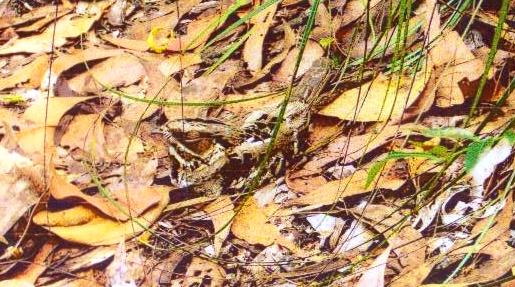| WILDWATCH: by ANNE WILKINSON Some years ago, most of our nights here in the Wildwatch forest would be disturbed by a regular sound. It was just as if a neighbour had decided to hammer in a post and was setting stoically about the task. Once one realised it was a bird, not a thoughtless human making it, the noise, like that of so many other wild sounds at night, seemed to blend in and it was hard to be irritated. |
The reason for the bird’s mention now is that it came up in conversation recently that for a couple of years now no one we have asked had heard it. We too had not, yet when we first arrived in the region nearly nine years ago, hammer birds were regularly heard in our patch of bush.
In looking back, we realised the sound had gradually dwindled from the usual night-time assault, until for the last probably two years, we had not heard that distinctive “tock, tock, tock” at all.
It is likely that Cyclone Yasi is partly to blame, for the bush inhabited by these ground nesting birds was savagely damaged. But what about before Yasi? Apparently, according to long time residents, years ago hammer birds were very common in our woodland. But not any more.
Could the problem be wild pigs? This night bird roosts during the day either on the ground or close to it, in thick cover. But so does the bush stone curlew, and these can still be heard, although once again not as often as they used to be.
I have never seen a nightjar fly, but people who have said its flight is both swift and agile. It chases the moths and other flying insects on which it feeds through the scrub, dodging trees and other obstacles with ease.
The nightjar’s camouflage, as witnessed by this wonderful photograph by Vic Dowd of Munro Hill, is phenomenal, the beautifully patterned feathers almost exactly copying the dead leaves, fungi and other cluttered detritus of the forest floor on which it rests. When its large dark eyes are closed, as in this photograph, it is all but invisible.
But of course, for a hunting creature like a pig, it has a scent.
Who knows..
We would be delighted to hear from someone who can refute our fear that this iconic Australian bush bird, so irritating in some ways yet, like the raucous dawn call of the kookaburra, such a familiar part of classic Aussie bush, is gone or vanishing.
Once we got used to its sound, it had always seemed special to have it on our patch. It would be nice to know it is still around.
Remembering the naked, broken forests after Cyclone Yasi it is satisfying to look around now and see so much leaf and indeed, flower in many of the trees. Not only that, but large numbers of trees which appeared to be dead are now fighting back. Having been cut down to stumps, those stumps now are sprouting leaves. How we wish we had not chopped them, but had left them to battle on.
It is really hard to know what to do for the best when confronted with all the damage after such a massive cyclone as Yasi, but there is a strong message if another such major event occurs.
It is give damaged trees a chance. Unless they are dangerous and may fall and injure someone or damage property, leave them alone or, if lopping or felling is necessary, make the cut higher.
The good news is that so many people are planting trees. Literally thousands have gone from Council and regional nurseries for planting out.
There are so many beautiful varieties up here choice may seem difficult, but consider the soil, the aspect and, especially important now, the local wildlife which will be depending upon them, and the choice narrows.
This is a wonderful opportunity to restore and add even more beauty to this very special region.



